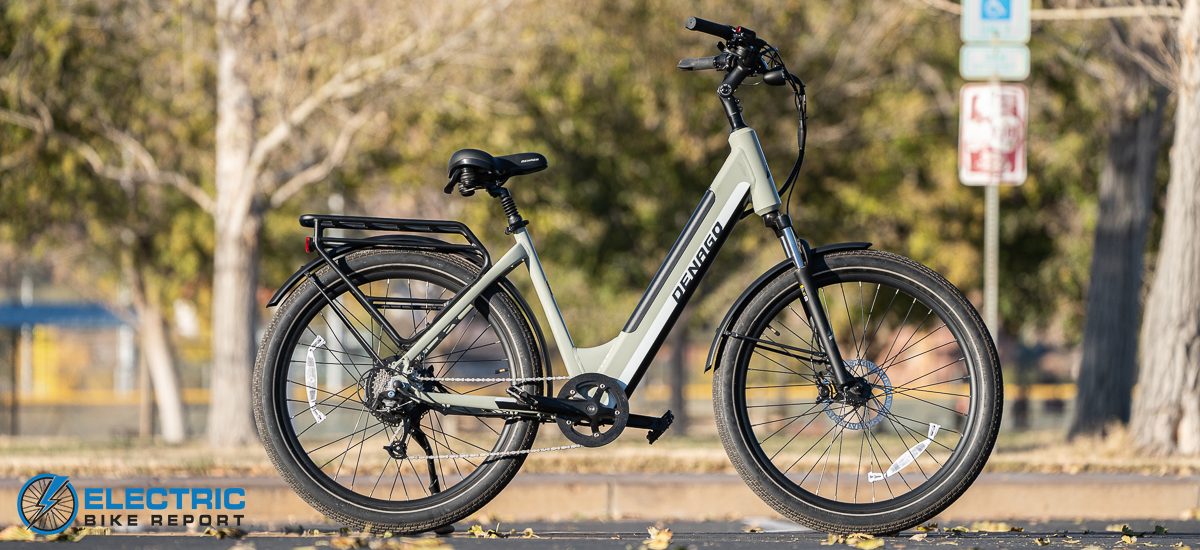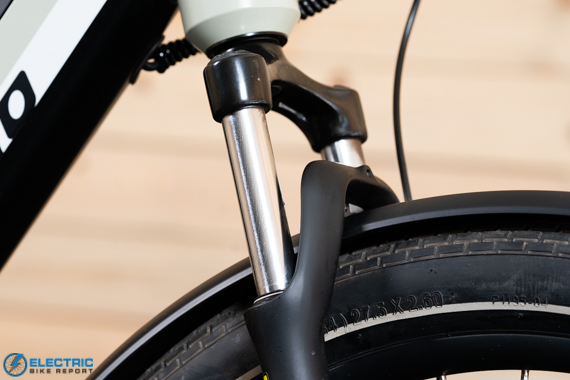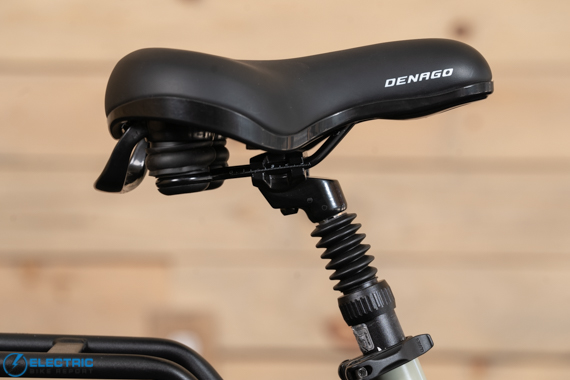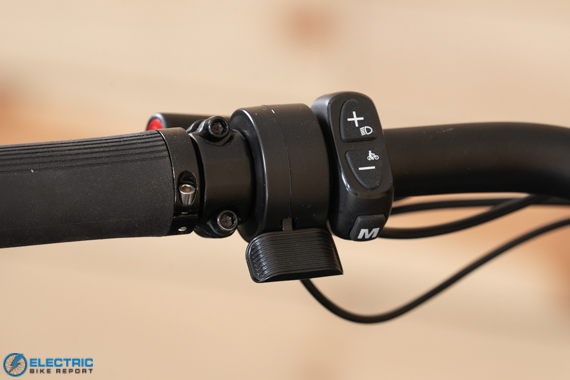Denago Commute Model 1 E-Bike Review 2024

Their first offering was the Denago City Model 1, which impressed us in its review with its particular combination of performance and value. They managed to deliver a fun class 3 e-bike at a price point we don’t often see. With such a solid debut, we weren’t just hopeful that the Denago Commute Model 1 would be a great buy, we had our expectations set to encounter a ready-made commuter with the features we believe any commuter needs to park their car and ride to work daily. Frankly, we couldn’t wait to review the Denago Commute Model 1.
Building a value-rich commuter serves as a rite of passage for e-bike makers, especially in the ever-competitive $1500-$2000 price point. Anyone can build a fantastic $3500 commuter e-bike, but below $2000 manufacturers are forced to choose between features meant to set their commuter apart from the rest of the field.
The mold is set for full-fledged commuter e-bikes, so to speak. To grab a consumer’s attention, a good commuter will have at least a 500W motor, a 7-speed drivetrain, needs to have capable brakes and should include lights, fenders and a rear rack. Massaging those details is what distinguishes a great commuter e-bike from just a good one. The Commute Model 1 has all of that and then some.
falt
Overall the Commute Model 1 was set up with success from a parts-pick standpoint and then it was a matter of threading the needle to get them to mesh well so that it has the ever-important feel of a good d-bike.
Let’s jump into our review of the Denago Commute Model 1 and see if they were able to pull it off.
 Pro’s
Pro’s- 500W Shengyi brushless hub motor has plenty of acceleration and the power to deliver riders to a Class 3 max speed of 28 mph
- 653Wh integrated battery has a low-key look and provided 27 mi. of range in PAS 5
- 8-speed drivetrain offers a wide range of gears to climb hills and hit near the Class 3 speed limits
- 27.5 x 2.6-in.-wide tires roll quickly and offer a smooth ride
- Taller riders will appreciate the L/XL frame size and its comfortable reach
- PIN lock provides added security from theft
 Con’s
Con’s- The display shows relevant info but has a rather dated look
- The fenders help mitigate some splashing, but hopefully a more elongated fender in the future could do an even better job as we noticed a few drops landing on legs while going through puddles.
- Battery: 48V, 13.6Ah, 652.8Wh
- Display: LCD with PIN lock security
- Motor: Shengyi rear hub motor, 48V, 500W, 50 Nm torque
- Headlight: Included
- Taillights: N/A
- Peal Assist: 0-5
- Range: 45+ mi. claimed
- Throttle: Included
- Claimed weight: 66 lbs.
- Maximum rider weight: 280 lbs.
- Maximum load on rear rack: 55 lbs.
- Brakes: Zoom hydraulic disc, 180mm rotors
- Fenders: Included
- Fork: 6061 Aluminum
- Frame: 6061 Aluminum
- Drivetrain: Microshift 8-speed
- Grips: Rubber, lock-on
- Saddle: Comfort-style
- Handlebar: Alloy, 660mm wide
- Kickstand: Included
- Pedals: platform alloy, with reflectors
- Tires: 27.5 x 2.6 in. e-bike-rated
Denago Commute Model 1 Review: Bike Overview
The Denago Commute Model 1 takes aim at the many plug-and-play commuters out there, like the Rad Power Bikes RadCity 5 Plus. The Denago Commute Model 1 is built around a 500W Shengyi hub motor, a 653Wh battery, 8-speed drivetrain and includes a headlight, rear rack and front and rear fenders. It’s a welcome sight whenever the typical commuter trimmings come standard. To keep the rider comfortable, they spec’d a suspension fork and a springy-feeling suspension seatpost.
In a move that we don’t often see in the $1500-$2000 price point, Denago not only offers the Commute Model 1 in both a traditional frame and a step–thru frame, they offer both frame designs in two different sizes in order to fit a wide range of riders (4’11” – 6’5″ across the different frames and sizes). It’s fairly common to encounter a one-size-fits-all approach, especially from newer companies, by putting on an adjustable stem and making sure the seat post is plenty long to adjust for taller riders. But the Commute Model 1 offers a welcome ability to find a more tailored fit.

The Denago Commute Model 1 is well equipped for riding comfortably thanks to the suspension fork and suspension seatpost.

Denago did a great job of integrating the battery into the frame to give a sleek appearance and keep the e-bike’s center of gravity low.

Denago includes a very stout rack that bolts to the frame more securely than we see with most designs.
The frame further defies the norm by coming in S/M and L/XL sizing. Usually, e-bikes are catering to national averages, so S/M and M/L are frequently seen frames meaning taller or smaller riders on the margins feel good, but not great. The choice to dedicate sizing for more distinct ranges is great as the medium crowd should still be comfy, but taller and smaller riders have a better bet of finding more ideal fits.
At first glance, the Denago Commute Model 1’s 500W motor may seem to be a modest amount of power, but the Shengyi motor delivers enough performance to deliver the bike to Class 3 speeds. The 653Wh battery proves to be an efficient pairing as well, and it melds into the bike in a way that looks stylish.
Denago Commute Model 1 Review: Motor Performance, Speed and Acceleration

In our circuit test we found the Denago Commute Model 1 to be a solid performer. This is a Class 3 e-bike with a maximum assist speed of 28 mph. For riders with a commute more than a few miles long, a Class 3 e-bike has the ability to shrink that commute time noticeably.
We didn’t see much benefit to riders in PAS 1 or PAS 2. In our circuit test, our test rider averaged 13.5 mph with no assistance. In PAS 1, that average speed climbed to 13.7 mph, a barely perceptible improvement. In PAS 2 its average speed climbed just a stick to 14 mph. We’d like to see a more noticeable level of assistance in these two PAS levels.
PAS 3 was the boost we were looking for from the Denago Commute Model 1. That was the point at which we finally felt like we were getting the experience people look for with an e-bike. On our circuit we averaged 16.7 mph. In PAS 4, we got a substantial jump in performance, climbing up to 19.2 mph. We were definitely impressed with PAS 5, which gave us a blazingly fast average of 24.9 mph, even with a hill thrown in.
This e-bike is ideal for anyone who wants to knock out their commute as quickly as possible aboard an e-bike.
Top speed is one thing, but the acceleration is quite impressive too. It gets right up to the “too fast” line without going over it for me. I appreciate speedy e-bikes, so those who don’t share that love of fast machines should note that it’s easy to adjust the speed down to something more mellow in the bike’s settings.

The large 27.5″ X 2.6″ tires handle well even in corners

The integrated battery and step-thru design offer riders a very low standover height.

The 8-speed Microshift drivetrain offers a greater gearing range than comparable 7-speed systems.
Denago Commute Model 1 Review: Range Test & Battery Performance
In our range test the Denago Commute Model 1 performed well at max power, but came up a little bit short in our lower PAS test. Now as you saw from the circuit results there isn’t much constant assistance in PAS 1 or 2 which is why we performed the low PAS test in PAS 3. The motor wouldn’t do much for you on flats in PAS 1 or 2 as the bike rolls well on its own so the lower levels really only kick on from dead stops and on hills. That will be ideal for some folks who want the exercise of pedaling but want to take out the sting of climbing hills.
But for the sake of our testing purposes we look to see what the battery distance is like with a constant feel of the motor engaged. With a total distance of 37.6 mi. on PAS 3, that’s shy of Denago’s projected 45 mi. range, but not a bad result within the context of our test.
Despite coming up a little short in the , any e-bike with a range of at least 35 mi. will provide most riders with days of commuting before needing another charge.
In PAS 5, we were far more impressed with the Denago Commute Model 1. It covered 26.9 mi. Normally, we see a much greater loss in range, especially with a Class 3 e-bike where the motor draws serious power to achieve higher speeds. Riders would need an exceptionally long commute to have trouble making the round trip in PAS 5.
Denago Commute Model 1 Review: Hill Test
The Denago Commute 1 is equipped with a 500W brushless, geared Shengyi hub motor that produces a very capable 50Nm of torque. In our experience 500W hub motors run the gamut from disappointingly weak to so powerful we double-check to make sure it’s really a 500W motor. Very often, the detail that determines just how well a motor performs is how much torque it produces.
In our test up Hell Hole, a ⅓ mi., 12 percent grade, the The Denago Commute 1 performed at the upper end of what we see for 500W hub motors. In PAS 5, it climbed the hill in 1:09 for an average speed of 15.7 mph.
We see a great many bikes that make it to the top of Hell Hole in PAS 5, but they can’t make the full trip on throttle alone, and there again, the Denago Commute 1 impressed. On throttle only, it climbed Hell Hole in 1:37, for an average mph of 11.2.
The charts above speak volumes. Compared to it’s peers with similar motors and bike styling, the Commute Model 1 is a hill climbing champion. If assistance with hills is a driving factor for your next e-bike then put the Commute Model 1 on your short list.

Amongst the things I most appreciate from reviewing the Denago Commute Model 1 the TRULY large frame stood out

The Shengyi 500W hub motor is tuned for true Class 3 performance; it provides excellent acceleration as well as climbing ability.

The 27.5 x 2.1-in. tires roll quickly and give great performance even on unpaved surfaces, while making for a comfortable ride.
Denago Commute Model 1 Review: Brakes and the Brake Test
The Denago Commute Model 1 is equipped with Zoom hydraulic disc brakes paired with 180mm rotors. It’s a solid setup and on par with most of the e-bikes we see in this price range.
In our three-pass brake test, the Denago Commute Model 1 performed reasonably well, with an average stopping distance of 24 ft. This is a bit of a so-so performance, but it’s a distance that sits firmly in what we consider to be acceptable. It’s not often that a rider will need to go from 20 mph down to dead stop post-haste.
Much of what we look for is enough power to control speed for ordinary riding conditions. We don’t want so much power that a hard pull on the brakes will result in locking up the rear wheel. We also appreciated that the brake levers included a motor cutoff switch, so should someone continue pedaling even as they brake, they won’t be fighting the motor to stop.
It’s also nice that these are hydraulics and not mechanical. Not much force is required when pulling on the levers to stop, and they just provide more confidence than mechanical brakes.
Denago Commute Model 1 Review: Ride Comfort, Handling and Cockpit
The three easiest ways to ensure a rider’s comfort on an e-bike are to spec: 1) tires at least 2-in. wide, the wider the better; 2) a suspension fork and 3) a suspension seatpost. Denago employed all three of these tactics when they designed the Commute Model 1. The 27.5 x 2.6-in. tires aren’t the widest we see on e-bikes, but they are wide enough to be plenty comfortable so long as they aren’t pumped up too hard.
The suspension fork does a nice job of making any road feel smoother and can be adjusted depending on the rider. A good suspension fork will make even rough roads easy to ride and will make the bike easier to handle.
The suspension seatpost takes the sting out of bumps without seeming like a pogo stick, bouncing the rider. It compresses a small amount upon hitting a bump, but doesn’t spring back noticeably.

The suspension fork not only makes the ride more comfortable, it improves the bike’s handling over bumps and pavement seams.

The suspension seatpost increases comfort in a way no saddle can. The seatpost’s movement is barely noticeable.

One of our only knocks against the Commute Model 1 was that the Zoom brakes were lacking a bit in power.

The Commute Model 1 includes a thumb throttle which can be used to accelerate to 20 mph and then pedal up to 28 mph.
The Denago Commute Model 1 was designed to be a capable Class 3 commuter. To do that, the bike needs to handle well at speed. Many bikes that feel nimble at 10 or 12 mph feel absolutely sketchy at 28 mph. The bikes that feel confident and stable at 28 mph feel a little lazy in their handling at low speeds. The Denago Commute Model 1 falls into this latter category so that at higher speeds the rider won’t feel compelled to slow down for the sake of their own survival. Were it a car, it might be a Toyota Avalon.
In turns, the Denago Commute Model 1 carves easily and holds an arc consistently, which is important to rider confidence when taking a turn at more than 20 mph. The middle of a turn is no time for nervous handling. It isn’t overly sharp or twitchy, but the bike handles how you’d expect for the styling.
We think the look of the display is a bit dated, and it could offer a bit more information, but we do like that it is big and sits above the stem, where it is easiest for the rider to see. We also like that the battery indicator features ten steps to give a more detailed picture of range and is big enough to judge at a glance. A thumb-button throttle sits just inside the left grip and the shifter sits just inside the right grip. The adjustable stem provides an important part of fitting the bike to the rider.
Again, we are deeply impressed that not only did Denago decide to offer the Commute Model 1 in both a traditional frame and a step-thru design, but they offered each version in two sizes. This is a big improvement on the one-size-fits-all frames. The reach to the handlebar is often the single biggest factor in cockpit comfort.
Denago Commute Model 1 Review: Summary / Where to Buy
New companies enter the e-bike market like Netflix dropping a new series. It’s hard to keep up with all of them. And just like a TV series, some of these new brands are good, some are awful and some are surprisingly good. We put Denago in this last category. Despite their short track record as a brand, the company was launched by people who have real experience in the e-bike market, which is how they avoided some of the rookie mistakes we’ve seen some brands make.
As we mentioned at the beginning of this review, the $1500-$2000 price point is an especially competitive one in general and even more so when looking at commuter e-bikes. If we took all the best features we find on the various commuter e-bikes that retail for less than $2000, we would have a commuter with a 750W motor, a 650-750Wh battery, an 8-speed drivetrain, hydraulic disc brakes, a suspension fork and seatpost, plus lights, fenders and a rear rack.
The Denago Commute Model 1 isn’t a perfect e-bike; at this price point none of them are. What Denago created is a bike that makes for a very intelligent buy. Yes, the brakes could be better and we think the display is rather antiquated, but again, at this price point, we can’t expect every single feature on this e-bike to be top of its class.
When we consider the features that people tell us matter most to them—speed, plenty of gears and power to get over hills, a rack, fenders and lights, the Denago Commute Model 1 hits those notes pitch-perfectly.
It’s easy to overlook the fact that Denago makes the Commute Model 1 in two different frame styles and two sizes each for the traditional frame and the step-thru frame. Considering they also include an adjustable stem—and let’s not forget the suspension fork and seatpost—and the Denago Commute Model 1 deserves some sort of award for making rider comfort such a high priority. Our tallest testers (myself included) were especially grateful that the large step-thru frame was as large as it is; we aren’t always all that comfortable on the one-size-fits-all bikes.
Considering that a commuter is generally purchased to be ridden on a daily basis, comfort doesn’t just matter on any one ride. An e-bike that is too big or too small may not be all that uncomfortable on one short ride, but a year’s-worth of riding on the wrong bike can ring up quite the tab with the chiropractor.
Denago has created an instant go-to for the commuter category. Perhaps the best thing we can say about the Denago Commute Model 1 is that it can make going to work more fun.
‘Happy Riding, make sure to let us know if you have any questions down in our comments section or if you think we left anything out in this review of the Denago Commute 1.


